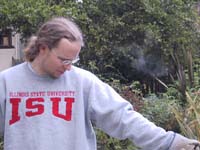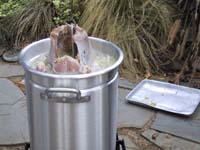|
Geek Fried Turkey - Thanksgiving 2003 |
back |
||
|
Deep frying a turkey is not a simple thing. It's dangerous, and expensive, and setup takes time. If you go out on the net you will find lots of sites that extol the delicious result of this process. You can buy all sorts of related products (rubs, bastes, and, uh... baste injectors) but detailed information on *how* to fry is scarce and spread across a variety of sources. This is the lowdown on deep fried turkey. To skip the commentary and go straight to the slideshow, click here To Begin: Here is a list of basic recipes. Equipment: We used 5+ gallons of peanut oil, in a 40 quart fryer. Bird: The turkey was about 15 lbs, treated with olive oil, salt and pepper. It was fresh (not frozen) and in the refrigerator the morning of the event. Team Geek Fry (hereafter: TGF) modified the turkey some to make sure the neck hole was nice and big - cutting an extra vertebrae. After puncturing the skin under the legs, and inserting the hook/cook apparatus, we let the turkey stand and warm to room temperature. In addition, the turkey was dried with towels just before dipping - a wet turkey going into hot oil creates lots of fizzing and can lead to fires. See this demonstration from the kind folks at Underwriters Laboratories. Really - watch it before frying. It will keep you from drinking and frying, dancing and frying, and possibly, from frying all together. Disclaimers: Because not everyone is a super-anal geek, I have to say some stuff here about danger. Anything related to this stuff is covered with disclaimers. There are all sorts of caveats in the recipes and instructions for the fryer about how big of a bird to work with. In that grand tradition I will state here for the record that this doc is for entertainment purposes only - Please READ and FOLLOW the directions that come with your fryer!!!
|
||
 |
 |
 |
|
Clothing: If you are reading this, chances are that you already wear plenty of skin-protecting clothing (tastefully decorated with the logos of long-dead software/game companies) all the time. But be sure to break out some not-too-important-yet sturdy garments for this operation and some gloves. Tie those nerdlocks back (if you still got 'em). Also - consider goggles. Location: Where to fry? After considering both the front patio and the driveway (and then hearing tell of YET ANOTHER deep-fried three alarm - thanks Kate!) TGF moved the entire kit to the backyard - far far away from the house, the baby, and any small dogs.
|
||
 |
 |
 |
|
Getting Started: First, determine the total amount of oil you will need. Most guides suggest that you measure out water and submerge the turkey as a practice run, and leave about 5 inches between the surface and the lip of the pot - sometimes marked by a fill line on the pot itself. During the heating phase, the oil itself will expand (duh - and yet, none of the recipes we found mentioned it) - to the tune of about an inch. Given this, and bubbling (2-4 inches high at the center of the pot), we'd suggest that you measure to leave 6-8 inches of space between the surface of the unheated oil and the lip of the pot. With boil, and expansion, you'll be at the fill line in no time. Flame: The flame was a point of much contention. How high? How hot? When you turn on the fryer it makes a lot of noise, so it sounds really freaky - but the propane flame is very hard to see in the daylight. Actually, it's almost impossible when not really cranked. Tests of the flame revealed that even on a medium setting, heat waves were visible up to 4 feet above the burner itself. Watch out for invisible but very hot jets from exhaust vents as well. No need to disfigure yourself for the holiday season. In the end, TGF decided to wing it (blowing all chances of a perfect score for the event). In the words of one fryer: "It was pretty cranked, but not quite maxed." Heating the oil: In our fryer, ~5 gallons of oil took ~40 minutes to heat up to 175 degrees. You have to watch this process the entire time. If the oil overheats - it can ignite. Of course, you should always keep the lid off during heating, to avoid flash fires. As the oil began to heat, "cool little convection vents" formed as bubbles rose to the surface. Taking photos of the boiling oil was scary, but neat.
|
||
 |
 |
 |
|
Dunking: The recipe we followed suggested dunking the turkey once slowly, and completely, and then performing a second dunk once excess moisture had boiled off. The short length of hook that comes with the frying kits makes this kind of frightening. If you don't use gloves you run a serious burn risk. In the UL video, they use a pole to lower it in. There was talk of placing the turkey in a baby harness and lowering the bird as if it were "on belay" - but as you can see, TGF resorted to good old-fashioned manpower. Submersion: As the bird was lowered into the oil, it sputtered and popped furiously. Checker and Doug both took turns making silly and/or dubious faces - mostly at each other but occasionally at the camerawoman. Be sure to have some sort of poking implement to edge in stray limbs.
|
||
 |
 |
 |
|
Cavity: These dunking photos were taken over the course of about a minute. Watch out for convection sprays as the cavity of the bird fills with scalding oil. Note the smoking cavity - it was probably the most picturesque moment of the entire fry. Like we were making witches brew!
|
||
 |
 |
 |
|
Fill Line: As you can see - by the time the bird was 2/3 submerged, the boiling, roiling oil had reached the fill line - not good. We failed to account for boil or expansion mentioned earlier - and so ended up with about a quart or so of excess oil in the pot.
|
||
 |
 |
 |
|
Capacity: This was a fire hazard. I repeat - we really could have set ourselves on fire. As the bird went down, oil started to kind of gurgle over the sides. Fortunately for us, the pot was *slightly* tilted (it was on a pristine, natural slate tile - now a well-greased slate tile) so the oil tended to roll down one side and to the ground, instead of into the heating element (where it most certainly would have ignited).
|
||
 |
 |
 |
|
Puppies: Eventually we were kind of freaked. The oil was looking scary. And that's when the dogs showed up! Yes that's right - just as we reached critical capacity in the fryer, two very adorable and spastic Jack Russel terriers came out to the patio wanting to have their bellies scratched. Mania!
|
||
 |
 |
 |
 |
 |
 |
|
Ladling: Lucky for us, Jane was soon on the scene with a handy ladle and oil-proof bowl. After removing several (10?) ladles of scalding fluid, the boil was reduced to a safe distance from the fill line. The boil itself was highest at the middle - but splashes were pretty minimal once the ladling was done. No, we did not fry any puppies.
| ||
 |
||
| |
||
 |
 |
 |
|
Timing: The thing about frying a turkey this way (in case you didn't already know) is that it's really fast. Like - 40 minutes after submerging this thing, it was completely cooked. The meat thermometer (measure in both the breast and the thigh) was well within range (180 degrees) on our first try. Be forewarned - the bird inside that crispy shell is very hot. Scalding juice sprayed out when we poked the turkey with the thermometer.
|
||
 |
 |
 |
|
Removal: It's probably not a good idea to lean over the propane tank while removing the bird as seen here - kind of careless to be anywhere near the tank and stooping - especially if you're wearing slippers and the ground is oily. But whose counting? The bird, as you can see, was completely fried - really crisped nicely. Not black, not smoking - nice and crispy. It smelled... fried. But in a good way.
|
||
 |
 |
 |
|
Afterward: This is a very dangerous time - because the oil is SUPER FRIGGIN HOT and there is nothing in it to absorb or convey heat to the surface - so it will start to heat very rapidly if you are not watching it and adjusting the temperature accordingly. If you plan to put another bird in, (TGF decided, for some reason, to fry a chicken) you'll want to have a responsible, non-drunk adult on guard to turn the flame down as the oil begins to heat again. Or the closest thing to such a person. The chicken took roughly 10 minutes to fry. Cooling: It is important to allow plenty of time for the bird to cool. We were at least 40 minutes from eating when the bird came out of the fryer. Be sure that the reasonable, intelligent and capable adult (or substitute) mentioned earlier is able to watch things if there are any small children or animals in the vicinity of the cooking setup. A spilt bucket of recently-boiling oil could really spoil your meal. Cleanup: After the oil has cooled (read: a long time after you cook the food and consume it) you can strain the oil back into its original containers (using cheesecloth and a funnel) and stow it away for next year. Supposedly, it keeps for "ages". FYI: The white stuff on the ground in these later photos is baking soda, which we hoped would absorb excess oil from the once-pristine garden slate. Oh well.
|
||
 |
|
|
|
Eating: We
seasoned the turkey with fresh rosemary from the garden. It was
delicious. The skin was crispy but not oily at all, and the meat
itself was juicy and tender. I personally carved the leftovers the
next day - and it tasted just as good cold. Crispy skin was a great snack
(and I used to be a vegetarian!!) and the wishbone survived in tact.
For the epicurious: we ate
this turkey with 50s-style sweet potatoes & almonds, creamed
onions, superior not-stuffing stuffing, fresh green beans, homemade
cranberry sauce, mashed potatoes, homemade gravy, champagne and plenty
of wine. Dessert included persimmon pudding, pumpkin pie, and apple
crumble (I ate the last piece for breakfast!!) with fresh whipped
cream. Company: Above
all, this meal was spectacular thanks to the folks sitting
around the table. They made Thanksgiving 2003 one of the best in my relatively short (but
thankfully continuing) life. PS: We didn't
even touch the chicken. |
||